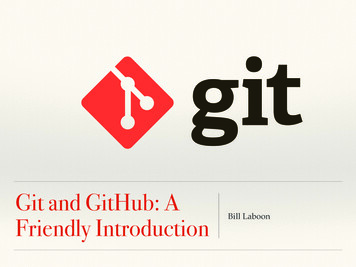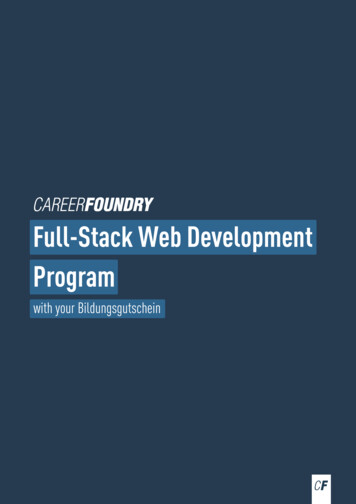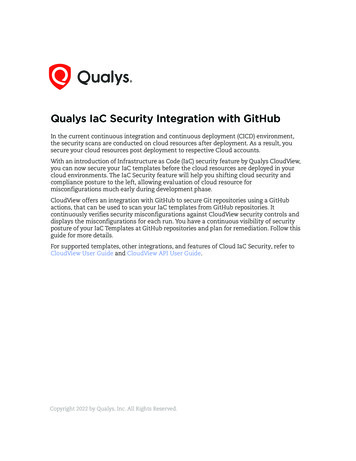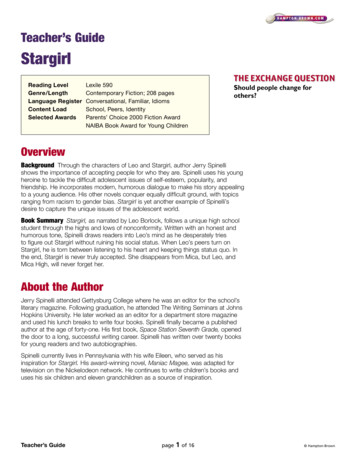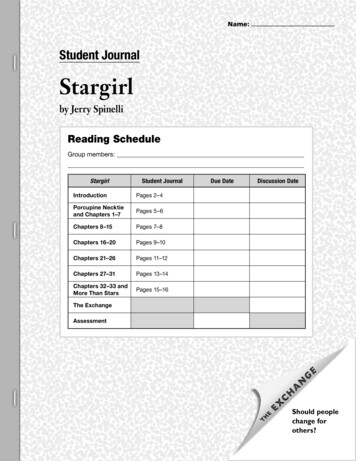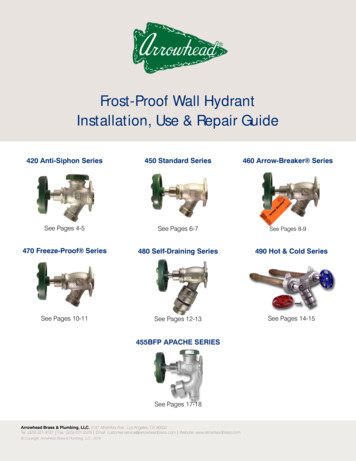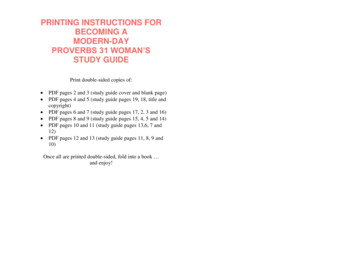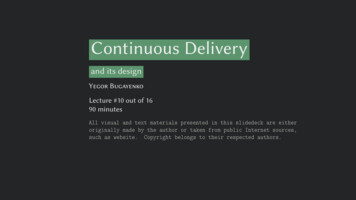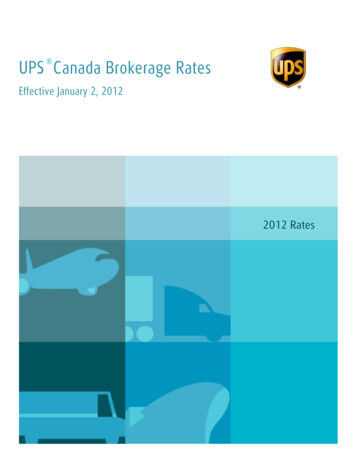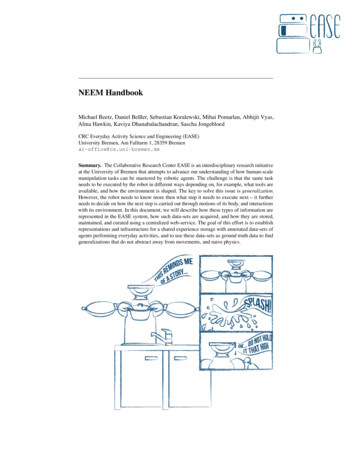
Transcription
NEEM HandbookMichael Beetz, Daniel Beßler, Sebastian Koralewski, Mihai Pomarlan, Abhijit Vyas,Alina Hawkin, Kaviya Dhanabalachandran, Sascha JongebloedCRC Everyday Activity Science and Engineering (EASE)University Bremen, Am Fallturm 1, 28359 Bremenai-office@cs.uni-bremen.deSummary. The Collaborative Research Center EASE is an interdisciplinary research initiativeat the University of Bremen that attempts to advance our understanding of how human-scalemanipulation tasks can be mastered by robotic agents. The challenge is that the same taskneeds to be executed by the robot in different ways depending on, for example, what tools areavailable, and how the environment is shaped. The key to solve this issue is generalization.However, the robot needs to know more then what step it needs to execute next – it furtherneeds to decide on how the next step is carried out through motions of its body, and interactionswith its environment. In this document, we will describe how these types of information arerepresented in the EASE system, how such data-sets are acquired, and how they are stored,maintained, and curated using a centralized web-service. The goal of this effort is to establishrepresentations and infrastructure for a shared experience storage with annotated data-sets ofagents performing everyday activities, and to use these data-sets as ground truth data to findgeneralizations that do not abstract away from movements, and naive physics.
Contents1Introduction1.1 Notation . . . . . . . . . . . . . . . . . . . . . . . . . . . . . . . .1.2 Scope . . . . . . . . . . . . . . . . . . . . . . . . . . . . . . . . .1.3 Overview . . . . . . . . . . . . . . . . . . . . . . . . . . . . . . .2NEEM-Background2.1 Types of Objects . .2.2 Properties of Objects2.3 Views on Objects . .2.3.1 Appearance .2.3.2 Structure . .2.3.3 Kinematics .2.3.4 Dynamics . .2.3.5 Naive physics2.4 Data Formats . . . .2.4.1 URDF . . . .2.4.2 DAE . . . .1345.789101012131617181819NEEM-Narrative3.1 Types of Events . . . . . .3.2 Roles of Objects . . . . . .3.3 Views on Events . . . . . .3.3.1 Occurrence . . . .3.3.2 Participation . . .3.3.3 Composition . . .3.3.4 Transformation . .3.3.5 Conceptualization3.3.6 Contextualization .212124242425262628294NEEM-Experience4.1 Kinematics . . . . . . . . . . . . . . . . . . . . . . . . . . . . . .4.1.1 Pose data . . . . . . . . . . . . . . . . . . . . . . . . . . .3132325NEEM-Hub353.3
0Beetz et al.5.15.25.3Prerequisite . . . . . . . . . . . . . . . . . . . . . . . . . . . . . .Downloading . . . . . . . . . . . . . . . . . . . . . . . . . . . . .Publishing . . . . . . . . . . . . . . . . . . . . . . . . . . . . . . .3637386NEEM-Acquisition6.1 Data Structure . . . . . . . . . . . . . . . . . . . . . . . . . . . . .6.1.1 Triple data as JSON object . . . . . . . . . . . . . . . . . .6.2 Robot NEEMs . . . . . . . . . . . . . . . . . . . . . . . . . . . . .6.2.1 Prerequisite . . . . . . . . . . . . . . . . . . . . . . . . . .6.2.2 Recording Narrative Enabled Episodic Memories . . . . . .6.2.3 Add Semantic Support to your Designed Plans . . . . . . .6.2.4 Summary . . . . . . . . . . . . . . . . . . . . . . . . . . .6.3 VR NEEMs . . . . . . . . . . . . . . . . . . . . . . . . . . . . . .6.3.1 Prerequisite . . . . . . . . . . . . . . . . . . . . . . . . . .6.3.2 Recording Virtual Reality Narrative Enabled Episodic Memories6.3.3 Transferring VR-NEEMs into the Knowledge Base . . . . .6.3.4 Using VR-NEEM Data in CRAM plans . . . . . . . . . . .414142434344444647474848497NEEM Quick-start Guide7.1 NEEM Checklist . . . . . . . . . . . . . . . . . . . . .7.1.1 Kinematic information with visualization meshes7.1.2 NEEM Data format . . . . . . . . . . . . . . . .7.1.3 Semantic Annotation . . . . . . . . . . . . . . .7.1.4 Semantic Annotation: KnowRob . . . . . . . . .515151525253Appendix8.1 Agent owl file . . . . . . . . . . . . . . . . . . . . . . . . . . . . .8.2 Environment owl file . . . . . . . . . . . . . . . . . . . . . . . . .References . . . . . . . . . . . . . . . . . . . . . . . . . . . . . . . . . .555562658.
1IntroductionD. B ESSLER , S. KORALEWSKI , M. P EMHUBcuronThis document, referred to as the “NEEM Handbook” hereafter, describes theEASE system for episodic memories of everyday activities. It is thought to provide EASE researchers with compact but still comprehensive information about whatinformation is contained in NEEMs , how it is represented, acquired, curated ionsimulationobservationFig. 1. The EASE system for acquisition, curation and publication of episodic memories
2Beetz et al.Narrative Enabled Episodic MemoriesWhen somebody talks about the deciding goal in the last soccer world championshipmany of us can “replay” the episode in our “mind’s eye”. Those episodic memories canbe seen as abstract descriptions that allow us to recall detailed pieces of informationfrom any experienced activity. Having those detailed memories, we can use them tolearn general knowledge or map similar memories to unknown situations, so we knowhow to behave in the given situation.EASE integrates episodic memories deeply into the knowledge acquisition, representation, and processing system. For every activity the agent performs, observes,prospects and reads about, it creates an episode and stores it in its memory. Anepisode is best understood as a video recording that the agent makes of the ongoingactivity. In addition, those videos are enriched with a very detailed story about theactions, motions, their purposes, effects and the agent’s sensor information during theactivity.We define the episodic memories created by our system narrative-enabled episodicmemories (NEEMs ). A NEEM consists of the NEEM experience and the NEEM narrative. The NEEM experience captures low-level data such as the agent’s sensorinformation, e.g. images and forces, and records of poses of the agent and its detectedobjects. NEEM experiences are linked to NEEM narratives, which are stories of theepisode described symbolically. These narratives contain information regarding thetasks, the context, intended goals, observed effects, etc. The NEEM-experience andNEEM-narrative combined are so rich of information that the agent can replay anepisode to experience the seen activity anytime again.NEEMs are representations of experiences acquired through experimentation, reading,observing, mental simulation, etc. The main goal is to establish a common vocabularyused to annotate experience data across different tasks, scientific disciplines, andmodalities of acquisition, and to define models for the representation of experiencedata. The vocabulary is not just a set of atomic labels, but each label has a formaldefinition in an ontology. These definitions are done such that a set of competencyquestions about an activitiy can be answered by a knowledge base that is equippedwith the ontology and a collection of NEEMs .The NEEM model is formally defined in form of an OWL ontology which is basedon the DOLCE DnS Ultralite (DUL) upper-level ontology [1]. DUL is a carefullydesigned ontology that seeks to model general categories underlying human cognitionwithout making any discipline-specific assumptions. Our extensions of DUL mainlyfocus on characterizing different aspects of activities that were not considered in muchdetail in DUL, but are relevant for the autonomous robotics scope. These extensionsare part of an ontology that we have called SOMA 1 . A NEEM is made of severalpatterns defined either in DUL or in SOMA .1 https://ease-crc.github.io/soma
NEEM Handbook3While it is possible to create the representations listed in this document through acustom exporter, it is not advised to do so. Instead, it is advised to interface with theKnowRob knowledge base 2 . KnowRob provides an interface based on predicate logics that allows to interact with NEEMs . The language is a collection of predicates thatcan be called by users to ask certain types of competency questions covering differentaspects of activitiy, or to add labels and relationships in the NEEM-narrative . We willprovide example expressions in this document that highlight how the knowledge basecan be used to interact with NEEMs .1.1 NotationIn this Section, we will shortly introduce the notions and notations that are importantto follow this document.NEEMs are formally represented using an ontology. An ontology is a collection oflogical axioms in some formal language such as description logic (DL). The entitiesthat can be described in DL can be either concepts (sometimes known as classes),and instances. An individual may belong to one or more concepts. A concept maybe subsumed by another concept. Between individuals there may be relations calledobject properties, and, in addition, an individual can also have data properties thatlink it to some data values. As an example, let us assume that Alice and Bob are bothindividuals belonging to the concept Human, and that the object property hasChildconnects Alice to Bob, i.e. the relation asserts that Bob is a child of Alice. We may alsoknow the height of Alice, which would be represented by a data property hasHeightwhose value could be a string such as 1,7m to represent that she is 1.7m tall. Inthe following, to make clear when we are talking about concepts and when aboutindividuals, we will denote the set of all concepts as T (called the TBox), and the setof all individuals as A (called the ABox).It is useful when describing concepts to emphasize the concept names such that it isclear we reference the concept, and not the colloquial word. As such, Concepts andrelations will be written in a different font. Note that the name of a concept alwaysstarts with an uppercase letter, whereas the name of a relation with a lowercase one.Any word appearing in a concept or relation name after the first one will always beginwith an uppercase letter.Ontologies are meant to build on one another, and it is not uncommon for an ontologyto collect thousands of concepts from external ontologies it imports. To prevent nameclashes, in actual usage the names of concepts, relations, and individuals are oftenname-spaced. In this document, since we mostly talk about concepts from the SOMAontologies, the namespace will not be made explicit. An exception will be made insome diagrams where we reference concepts defined in more basic ontologies, such2 https://github.com/knowrob/knowrob
4Beetz et al.as those used to define the Ontology Web Language (OWL). An example is a namesuch as xsd:double; in this case, xsd is the namespace.1.2 ScopeThe broad scope of this work is to provide information about how robotic manipulationactivities are represented, acquired, curated and published in the EASE system forepisodic memories. We are in particular interested in aspects of interaction forces andmotion characteristics of objects participating in an action, since it is these physicaland geometric considerations that are crucial for successfull action execution. Thegoal is to learn models from collections of recorded data semantically annotatedthrough concepts defined in the NEEM model. The rich semantic annotations enablequerying and filtering the data, such that a robot can formalize a learning problemfor itself and curate its training data to be appropriate for it. Information about howthe data is collected, with what methods, from what agents, in which contexts, isimportant for this process, as machine learning techniques are sensitive to trainingdata biases. Note that in principle episodes can be stored of any agent performingany activity, and in actuality many of the NEEMs we expect to store will comefrom humans demonstrating how to perform a task. NEEMs are therefore not simplyintended as a kind of self-practice journal, but rather as a store of practical knowledgeof a variety of agents, useful for a variety of autonomous, humanoid robots.The kinds of knowledge a robot needs for competent performance of its tasks arevaried. Usually, knowledge modelling in robotics and AI has focused on a symboliclevel, of actions treated as black boxes that relate to a larger plan by means of theirpreconditions and effects. Actions are also very underspecified when described inspoken commands. This abstract level of description however is insufficient; thephysical details of the actions matter. For example, the angle and speed with whicha pitcher is moved, and the amount of liquid in it, determines whether there will bespillage. A robot needs to choose appropriate parameters for its actions, and inferthese parameters when they are left unspecified in a command.Such inference requires the robotic agent to be equipped with common-sense and intuitive physics knowledge, as well as an abstract task and object model, and knowledgeof how to apply these models in a given situation. The NEEM model attempts to support each of these requirements. A brief list of some of the over-arching competencyquestions follows. How are actions conceptualized? What is an action, how does it relate to otherconcepts an agent might have about the world? What is the purpose of an action? What is the structure of an action? How do several actions make up another?What objects participate in an action and with what roles?
NEEM Handbook5 How are qualitative and quantitative features of the world represented? Whatis the parameter set of an action? What regions can values for these parametersoccupy? What is a good parameterization and how can one be found? How are the physical interactions that underlie an action described? What are theinvolved forces, and how are they parameterized? What are relevant qualitative,and thus more general, descriptors for interactions, such as balance, blockage,compulsion? How are qualitative aspects of interaction grounded in quantitativephysical phenomena? How are objects conceptualized? What roles can an object play? What actionscan it take part in? What kinds of objects are necessary for an action? How is an action recorded and described? What is the relevant data to capturehow an action unfolded? What are the relevant pieces of contextual informationfor describing an action that has actually occurred? What was the outcome of theaction, in particular, to what extent did it match the goal? How is a learning problem formalized? What is the optimization goal? Whatassumptions were in effect when collecting the training data? What sort ofinfluence might biases have upon the learned model? What should be essentialfeatures that a learned model should use? What would be sanity checks on thelearned model to verify it does not abuse spurious correlations?1.3 OverviewNEEMs are the central data structures that link research results of various subareas within the collaborative research center EASE . EASE is an interdisciplinaryinstitution headed by leading researchers in the fields robotics, human cognition,formal logics, and linguistics. The overall goal is to make a robot more competentin performing everyday activities. This is accomplished by equipping the robotwith models learned over experiences represented as NEEMs . The purpose of thisdocument is to provide detailed information about the EASE system for episodicmemories. That is how NEEMs are represented as knowledge bases linked to timeseries data, acquired through experimentation, observation or simulation, stored ona centralized server, and maintained as a dataset for the research community. Thearchitecture is shown in Figure 1, and will be summarized in the remainder of thissection.At the core of the EASE system for episodic memories is the NEEM data structure.It is a heterogenous datastructure that contains data in different formats to represent different categories of information about everyday activities. Each NEEM ismade of three parts: background (Chapter 2), narrative (Chapter 3) and experience(Chapter 4). The background represents physical activity context by characterizingthe environment, and agents that play a role during the activity. A single background
6Beetz et al.may be shared in mutiple NEEMs . The narrative is a representation of events thathappened, their characterization and contextualization. That is, for example, thatan event occurred, what roles objects played during the event, how the event wascarried out through motions and interactions, and what the reason of its occurrenceis. The narrative provides labels used to annotate the time-series data stored in theexperience of the NEEM . This is done by associating the event time intervals to slicesin the time-series database. The experience data is used to capture some aspects ofkinematics and dynamics of an activity, that is how objects moved, how they got intocontact with each other, and how forces act upon objects.NEEMs are stored on a publicly accessible infrastructure that we have called theNEEM-hub (Chapter 5). The NEEM-hub builds on top of common infrastructure usedin data science to continuously update models learned from NEEMs . Uploading aNEEM requires to create a new data set on the NEEM-hub GitLab interface whereusers can provide documentation, usage examples, additional links and referencesfor their NEEM data set. Once a user is satisfied with the state of the data set, itmay be published. This will make the data set accessible via the knowledge serviceopenEASE where users may search for data sets given some keywords, download thedata set, or investigate it in an interactive environment.As EASE is an interdisciplinary effort, there are also different modalities under whichNEEMs can be acquired. We haved developed multiple acquisition infrastructures thatsupport researchers from different domains to acquire NEEMs (Chapter 6). This is,first of all, an interface that integrates with a robot control system either in a simulatedor real-world scenario where the robot senses its surroundings, and executes specificplans through motions of its body and interactions with its environment. A secondacquisition interface integrates with simulated virtual reality environments in whichhumans perform everyday activities. In this case, the intentions are not certainlyknown because even when told to do something specific, a human may do someunrelated experimentation in the virtual reality. The state of the environment includingforce characteristics can, however, fully be monitored.
2NEEM-BackgroundD. B ESSLER , M. P OMARLAN , A. V YASThe NEEM-background represents the (physical) context of NEEMs . More concretely,the NEEM-background represents the environment where events took place, and theagents that are involved. These are representations of physical objects, their parts,properties, and relationships between them.Each NEEM must have exactly one associated NEEM-background . This is importantas only the objects and their properties represented in the NEEM-background may beinvolved in events that occur in NEEMs . Consider, for example, a robot fetching acup in a kitchen environment to prepare a coffee. The cup would be part of the NEEMbackground while the fetching event carried out by the robot would be represented inthe NEEM-narrative (Chapter 3).The way how a task can be solved best depends on what is available in the environment.The suitability of an object to be used to perform a certain task is often derived from theclass of objects it belongs to, e.g., a knife can be used for cutting. The NEEM modeldefines a set of more general object classes such as agent and artifact (Section 2.1).These are used to classify each object represented in the NEEM-background . Theusability of an object is, however, ultimately grounded in its properties, e.g., a dulledknife may prove to be unusable to perform a cutting task. It is thus also relevant tocharacterize object properties as they correlate with how an agent may solve its task.Consequently, we treat types of object properties as classes organized in a taxonomy(Section 2.2).NEEMs may characterize different aspects of the environment depending on whatinformation is accessible when the NEEM is acquired. We organize different characteristics in so called views (Section 2.3). Each view has its own set of types andrelationships to represent the environment from a specific viewpoint such as appearance or kinematics.
8Beetz et al.NEEMs are heterogeneous representations that may include additional data files.These representations are time series data that are annotated by the NEEM-narrative .In addition, some widely used data formats for the representation of objects are supported (Section 2.4). Such data files may be stored within the NEEM-background ,associated to objects it represents, and used to enrich knowledge about the environment.2.1 Types of ObjectsObjects and agents that appear in an environment are classified as physical objects.Physical objects are exactly the objects you can point to, as they have a location inspace.The most common physical objects in non-natural environments are artifacts. Anartifact is an item that has certain structure, often to serve a particular purpose such asto use it in a certain way, or to enjoy looking at it in case of, e.g., an art piece. Artifactsthat were created with a purpose in mind are called designed artifacts. Most objectsin human-made environments belong to this category. Note that, e.g., a container isnot a designed artifact, as also objects that were not designed as such may serve ascontainers. Consequently, the class designed container is used for the objects thatwere designed to be used as a container. Other examples of designed artifacts are toolsand appliances designed for specific tasks or agents and the components designed tofit together to form a larger whole.Another category of objects are physical bodies. Most commonly one would use thiscategory for substances that appear in the environment such as a blob of dough, orthe coffee inside of a cup. However, it is more appropriate to classify the substance asdesigned substance in case it was created with a purpose in mind, for e.g., in the casefor the dough that is made according to a recipe and supposed to be eaten after beingbaked.Agents that appear in a NEEM are classified as physical agents. The difference fromother types of objects is that the agents have intentions, execute actions, and attemptto achieve goals, e.g., by following a plan and moving their body in a way to generateinteractions with the environment to cause intended effects. Each agent is composedof functional parts organized in a skeletal structure. Interactions with the environmentare carried out through effectors such as arms, legs, or hands. Effectors that are usedfor grasping are called prehensile effectors.The last top-level category in our object taxonomy is physical place. Places are objectswith a specific location such as the surface of a table, or the campus of the University.Each NEEM refers at least to the place where it was acquired, which is usually a roomin a building with objects that can be used to perform certain everyday tasks.
NEEM Handbook92.2 Properties of ObjectsQualities are the properties of an object that are not part of it, but cannot exist withoutit. This is, for example, the quality of having a shape – a quality inherited by allphysical objects. Another example is the quality of a floor having a certain surfacefriction and thus being slippery or not. A robot navigating on such a floor coulduse this knowledge to avoid, for example, spillage when moving on the floor with acoffee-filled cup. The quality concept does not directly encode the value of the objectproperty, but only focuses on characteristics of the property itself. This is mainlyuseful in cases where individual aspects of an entity are considered in the domain ofdiscourse.IntentTo represent the qualities of anobject.Competency What qualities does this objectQuestions have? What objects have thisquality?Defined in DUL.owlExpressionhas ingq A is a quality of o ASeveral sub-classes of Quality and corresponding sub-relations of has-quality are defined in the NEEM model. Some of them will be described later in this chapter.Each object property has one value at a time. The value is an element in a dimensionalspace. Such a dimensional space is called Region in the NEEM model. A regionmay have an infinite number of elements, or, in the other case, may enumerate all itselements. The color of an object, for example, may have a value encoded as RGBvector which is an element of the RGB colorspace (which is a region). Regionsmay further be decomposed into sub-regions, for example, to represent the subregion of RGB colorspace with dominant red color. Note that the domain of therelation has-region is not Quality but Entity. This is to allow assigning regions toentities without requiring an explicit Quality individual as an intermediate. Instead,the property connecting the Entity specifies what information the Region conveysabout the object.As an example, a PhysicalObject would be linked via a hasMassAttribute to a MassAttribute, that is, to a Region individual containing information about the object’smass. It is the relation hasMassAttribute that specifies what information the Regioncontains.
10Beetz et al.IntentTo represent values of attributes of things.Competency What is the value for theQuestions attribute of that entity?Which entities have a certainvalue on that parameter/attribute/feature?Defined in DUL.owlExpressionhas region(x,y)has data SD TypeMeaningy is a region of xy is a data value of x2.3 Views on ObjectsThe NEEM-background may represent several different views on the same objecthighlighting different characteristics that are fused in the NEEM-background toform a more complete representation of the environment. Each view has its ownvocabulary to describe objects including view-specific types of objects, qualities, andrelations, and has a distinct set of competency questions that may be answered incase a NEEM represents the view. A NEEM may not represent each supported view,however, it is recommended to represent as many as possible.2.3.1 AppearanceSOMA defines several concepts to represent qualities relating to an object’s appearance. The list includes, but is not limited to, Color, Shape, and Size . A quality belongsto an object, and can take values only from regions of an appropriate type.The shape of an object can either be represented as primitive geometry (e.g., box orcylinder), or as mesh. Primitive shapes are described by their geometric parameters,such as height, width and length for a box, and radius and length for a cylinder. Amesh shape, on the other hand, has a data property that is a URI of the file thatcontains the mesh data.IntentTo represent the quality of having a shape.Competency Does this objects have aQuestions shape?Defined in SOMA.owlPhysical ObjecthasShapeisShapeOfShape
NEEM HandbookExpressionhas shape(o)has shape(o,s)Meaningo A has a shapes A is the shape of o Axsd:stringxsd:doubleIntentTo represent the region ofshapes.Competency What geometric parametersQuestions has this shape? What is theURL where a mesh file of thisshape can be retrieved?Defined in SOMA.owlhasHeighthasLengthhasWidthhas shape data(o,sphere(r))hasURLBox RegionMesh xsd:doubleExpressionhas bbox(o,d,w,h)11hasRadiusxsd:doubleMeaningd, w, h R are the depth, width and height of thebounding box of o Ar R is the radius of the sphere shape of o AThe color of an object is a quality that may take values from a ColorRegion. Colorregions may be qualitative, such as GreenColor or RedColor, which correspond tosets of color values; color regions may also be specified as a single datapoint, i.e. astring representing the color’s components in some color space.IntentTo represent the quality of having a color.Competency Does this objects have aQuestions color?Defined in SOMA.owlExpressionhas color(o)has color(o,c)Physical ObjecthasColorMeaningo A has a colorc A is the color of o AisColorOfColor
12Beetz et al.IntentTo represent the color of physical objects.Competency What is the color of this obQuestions ject? Which objects have thiscolor?Defined in SOMA.owlExpressionobject color rgb(o,[r, g, b])Color RegionhasRGBValuexsd:stringMeaningr, g, b R is the RGB color data of o A2.3.2 StructureParthood represents that objects are composed of smaller things. These things may bephysical objects themselves, and a component of their direct parent in the partonomy.Parthood is transitive, that is, parts of parts are parts again, but componency is not.So one would say that the arm is a component of the robot, and that the elbow iscomponent of the arm, but not that the elbow is a component of the robot – howeverthe elbow is a part of the robot due to the transitivity of the parthood relation.IntentTo represent proper parthoodof objects.Competency What is this object componentQuestions of? What are the componentsof this object?Defined in DUL.owlExpressionhas component(x,y)Physical ObjecthasComponentisComponentOfPhysical ObjectMeaningy A is a component of x AHowever, another parthood type is needed for objects such as holes, bumps, boundaries, or spots of color that are physical parts but not a proper component of theirparent in the partonom
NEEM Handbook Michael Beetz, Daniel Beßler, Sebastian Koralewski, Mihai Pomarlan, Abhijit Vyas, Alina Hawkin, Kaviya Dhanabalachandran, Sascha Jongebloed CRC Everyday Activity Science and Engineering (EASE) University Bremen, Am Fal


